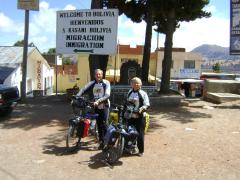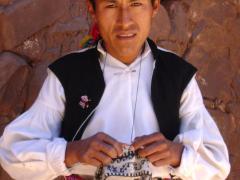Blogs
Riding around Lake Titicaca and into Bolivia
We rode from Puno, Peru to La Paz, Bolivia mostly along Lake Titicaca where the high-altitude lake reflected silver sunlight off the deep blue-green water. During the ride we saw villages harvesting reeds to make into mats, individuals making fishing nets, groups of people preparing the earth for the planting of potatoes, with mostly human power or oxen, but a few had the benefit of using tractors. The first night out of Puno, we outraced a tremendous storm and dove for cover in Ilave after riding 35 beautiful, flat miles. It was so good to be in a hotel room, dry, and safe from the blasting winds and pounding rain which lasted for most of the late afternoon and evening. The next day when we awoke the sun was shinning and the skies were clear. We rode another 49 miles enjoying vast open altiplano which was a wide open valley of dry flat fields. The closer we got to the Bolivian border the more we saw sheep and llamas grazing in the open valley. We even stopped for a photo shoot at the market in Juli where the livestock market was full of sheep and llamas. I saw live sheep hauled up on to the roofs of mini buses and lashed down. I watched as they stuffed live llamas inside the buses. I found it amusing to see a big bunch of live giant sheep on top of a van and a heads of llama sticking out an open window as the buses called colectivos drove past us. I was glad I was not one of those animals.
We stopped for the night in the last town in Peru called Yunguyo before we crossed into Bolivia. To our delight the town was celebrating the fiesta of its patron saint. read more here... lee mas aquí... »
Our Plan: To Uyuni and the Argentine Border by Bus
Thanks to all of you for your wonderful advice! After a week of resting in La Paz, Bolivia, here's what we have decided to do:
Tonight we're taking an all-night bus to Uyuni, in southern Bolivia, where we'll see the amazing Salar de Uyuni. After a few days there we'll take a train or bus to the Argentine border and ride south on the bikes to Salta, Argentina. In Salta we'll probably take some more time off, perhaps a month or so. Randy will try to pick up some work on the internet doing some web development, and Nancy will be refreshing some of her skills and doing some more drawing. Then we'll probably head south on the bikes and continue the ride.
Thanks so much for your care for us and for your encouraging comments!
Love,
-Randy and Nancy
Teetering on the edge! Help us with our decision
Update: See what we decided here.
We need your help! Please vote and help us decide what should be our next step.
After two years and 3 months of traveling by bicycle, we are tired and want a change or need a change. Our not-so-young bodies are complaining of the day and day out pounding of the roads of South America. But more than that our not-so-young minds are so full of what we've seen and done they don't seem to want any more. We have pedaled over 21,000 kilometers (13,000 miles) and bused, boated or hitched another couple of thousand kilometers. We have climbed many 4000 meter (13,000 foot) passes, pedaled to incredible beaches, passed months after months of farmlands filled with scattering of adobe homes and animals, sweated in the deserts, swatted the swarms of nasty bugs, visited cities, towns, tiny villages, churches, ancient ruins, museums and talked with thousands of people from many different walks of life. The turbulent economy has rocked us all. Even though we are in Bolivia, one of the poorest countries in the Americas, the financial situation in the US has affected our travel funds.
We are turning to of our loyal followers for support and advice in our moment of need. Please write to us and let us know what your advise to us would be.
Here are our options, as we see them:
End the trip here in Bolivia and head back home. read more here... lee mas aquí... »
Peru Wrapup
Pictures from southern Peru and Northern Peru are up... And our route maps and elevation profiles are all up-to-date as well.
Peru was a delightful and challenging country for bicycle travel. The people are warm and open and cry out "Gringo!" from every field and household. (This may be rude in "gringo" terms, but it's just friendly banter from most Peruvians. Who knows why everybody does this in Peru!)
It was also a hard country. We climbed to passes as high as we've ever been (4700 meters, over 15,000 feet) and suffered endless dusty dirt roads. The toilets (or rather outhouses) (if they existed) in rural areas were often of the "squatter" type, not the "sitter" type, where you put your feet beside a hole and aim at the hole.
The country is incredibly beautiful, with striking snow-covered mountains, green rice paddies, huge rivers, and everything in between. And, of course, it has Machu Picchu, which has to be one of the world's most beautiful places.
It was cheap most of the time, except around Cusco and Machu Picchu, where they have the squeeze of the tourist down to a fine art.
Some price examples:
- Hotels: US$5-10 for the two of us. Sometimes surprisingly good.
How much does your bike cost?
Ever since we got to Mexico we've had to deal with the question in every little village: "How much did your bike cost?" It's embarrassing and difficult. Our bikes are ordinary mountain bikes, middle-of-the-road affairs, but they cost around US$1000, which is more than a year's income for a Guatemalan family. It's more money than most campesinos in the countries we've ridden through will ever see. So if we say "1000 dollars", they go into shock. I don't think it makes the bikes more likely to be stolen, but it's just a terribly uncomfortable thing to discuss.
In the past we tried: "About 2 weeks' salary" (very unsatisfactory to all, since it's an honest and open question. Some friends suggested lying and saying "$200" or something. That doesn't seem too good either. We've tried "It was a pre3sent; I don't know." Also unsatisfactory. Everybody knows we know.
But recently one answer has been very successful. We say "It's our custom not to talk about prices and expenditures." They immediately nod their heads and drop the question. Es nuestra costumbre no hablar de precios. Since I was raised not to talk about such things, it's absolutely true. And people really respect it since they're used to respecting other people's customs. Anyway, a recommended response!
Entering Bolivia!
We entered Bolivia today. We asked cyclists already in the country whether they were sensing any unrest or finding any problems, and none of them were. So we decided to head on in. And even the news shows that all the issues have been in the eastern part of the country, which was far from our route anyway.
The one hurdle we had to cross that we haven't anywhere else on our trip: We had to get a visa! There was a gob of paperwork and $135/person to be paid for the privilege. Bolivia started this program (exclusively for US citizens) several months ago in the interest of "reciprocity". It only makes sense. If Bolivian citizens want to go the US, they have to jump through all these hoops (and far more, really). And we knew about this hurdle for many months.
We had thought we could get the visa cheaper ($100) Bolivian consulate at the last city in Peru, Puno, but when we showed up at their doorstep they told us they were out of visas and didn't know when they'd come.
For other cyclists, our friend Andrew wrote a great article about how US cyclists get a Bolivian visa.
The Islands of Lake Titicaca
Lake Titicaca is a massive lake, the highest navigable lake in the world at an elevation of 3,812 meters (12,507 feet). Both Peru and Bolivia share this deep blueish-green lake with several islands on the Peru side and several on the Bolivia side which are inhabited by indigenous people who mostly speak Quechua and Aymara, two languages that date from the Inca empire. A visit to the islands is an important part of visiting this natural wonder of the world.
We took a two day boat trip to three islands on the Peruvian side of Lake Titicaca: Uros, Amantaní and Taquile. We first visited the Uros Islands, which in reality are dozens of floating artificial islands. Each island is made of reeds which are bound together and maintained by the inhabitants. People actually live on these small floating islands in reed houses. Not only are the houses and the islands themselves made of reeds but they make boats out of them too. Is is fascinating to see all the different designs of boats made solely of reeds. The people of the islands used to make a living from fishing, but this has replaced by tourism on most of the islands. The women wear incredibly bright neon-colored clothes which glow against the yellow reeds and blue lake and pastel-colored sky. read more here... lee mas aquí... »
Pavement! Cusco to Lake Titicaca
We finally got started riding again and headed south from Cuzco on delightful paved road. It was paved all the way! Sometimes it was smooth, sometimes rough. Sometimes there was a good shoulder, sometimes not, but it was delightful. The traffic was moderate, the weather was good, the one climb (over a 4300 meter or 14,100 foot) pass was gentle. We took 5 days for the ride, and while we were tired when we got to Puno and Lake Titicaca, we were sure happy with the road.
We got to visit one ruin, Raqchi, that we'd never even heard of. But the guide was good and it was an interesting place, constructed in 1300 A.D. or so by the Incas apparently primarily as a food storage location, as there are more than 150 storerooms that were used for grain. But there were lots of artisans there too, as there still are today. read more here... lee mas aquí... »




